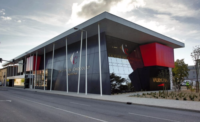
View outside of Bochner Chocolates in Iowa City after flooding.

Volunteers helping fill sandbags that were places around the 38,000-sq.-ft. plant.
Sure, the facility actually sits slightly above the 500-year flood plain. But as owner Eric Bochner explained, “That means there’s a less than 0.2% chance for flood waters to ever exceed that point.”
The devastating effects of the Iowa River flood last month, however, changed all that. On a now ever-to-be infamous Friday the 13th, Bochner’s plant and headquarters became surrounded by water on three sides. But for a twist of nature downstream - a levee gave way - the facility wasn’t swept away by the rushing waters.
Several days in the making – flooding warnings began to hit Iowa City on June 5 - the skies once again let loose in the water-logged state on Thursday night, June 12.. Earlier that day, Bochner - along with the rest of Iowa City’s 63, 000 residents - was anxiously monitoring reports of flood projections. The rains had swelled the Iowa River, and the nearby Cedar River had overflowed its banks by 12 feet flooding 130 square blocks of Cedar Rapids just 20 miles north of Iowa City. The Coralville Reservoir, located just a few miles north from downtown Iowa City, typically releases river flow at a rate of 3,000 cubic feet per second. Reports projected the flow to top 35,000 cubic feet per second.
Using laser elevation and surveyor tools, Bochner was at the plant trying to determine whether his life’s work would be in jeopardy. Early indications seemed to suggest the waters wouldn’t reach his facility. Bochner recounted, “Surveyors had spray-painted a 40,000 cubic feet per second line on the pavement as a worst case scenario. If the water stops there, our parking lot is wet, but no worse.” Then the rains came. The water levels rose overnight to the 40,000 cubic feet per second flow. The newest morning projections indicated that the river flow was expected to reach 50,000 cubic feet per second erasing the projected 14-inch cushion between the river level and the floor of the plant, and putting several feet of flood water into the building.
Rounding up his core crew early that Friday morning, Bochner made the decision to remove as much equipment as possible from the 38,000-sq.-ft. facilty.
“Luckily, the fork lifts had been charged up,” he told Candy Industry in an exclusive interview. “I told our guys to put as much as they could in boxes and elevate everything else. We put whatever equipment we could on whatever trucks that we could still find for rent. Those items we couldn’t move, we disconnected. We started at about 8:30 in the morning and worked throughout the day and late into the night, finishing about midnight.”
During that time, the river was continually rising and local roads away from the plant were closing. Volunteers helped to fill and place sandbags around the plant. By night’s end the city had issued a curfew prohibiting anyone from being within 100 yards of the new “riverfront.” Prior to leaving the plant, Bochner left a few freezers operational in the faint hope that the rising waters wouldn’t reach the building.
“Luckily for us, and unfortunate for those downstream, a levee broke just south of the city, which lowered the rise of the river in Iowa City. We were spared from the river flooding our building.”
The location, nevertheless, had now become a peninsula surrounded by water on three sides, sandbags providing a protective wall. At the time of the interview (June 17), city officials indicated it would take about two weeks for the river to return to its normal level.
In the interim, there’s “an obscene smell” to deal with on the outside, Bochner said.
There are also other challenges to face, such as simply “getting around.” Two of his managers had to find places to live, their homes either destroyed or inaccessible. With the additional widespread damage in nearby Cedar Rapids, finding truck drivers, electricians, heat/cooling specialists and machinists to begin the process of reconnecting chocolate processing and moulding equipment in the plant has proven to be an ongoing struggle.
Finally, there’s the process of adding up the costs.
Bochner estimated that simply reconnecting equipment, which includes such high-tech machines as an Awema moulding line and a Bosch flow-wrapper, will cost him between $20,000 to $30,000 in technicans’ time.
Total flood costs resulting from restarting the production processes as well as lost business – about 15% to 20% of the company revenues are tied to the local economy – will probably reach $300,000, Bochner believes.
“If we were flooded, the loss would have been in the millions, and we probably would have gone bankrupt,” he added.
As it stands, Bochner faces the challenge of retaining employees during the restart. He doesn’t foresee the plant being ready to produce chocolates until mid- or late July.
In summing up the ordeal, the young chocolate entrepreneur said it proved to be “a best case scenario in a worst-case situation.”
He admits never having thought twice about facing a natural disaster of this magnitude. Until that Friday the 13th, he didn’t even have flood insurance.
Ironically, just before the flood, the “plant was running really well, it was in great shape. I had just come back from interpack, having bought additional equipment,” Bochner said.
Despite the nightmare, he remains grateful. Current government estimates place damage throughout the area at $750 million. About 400 people have been displaced from their homes and many businesses and farms may never recover.
“We just survived this by luck,” he said.








